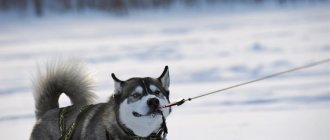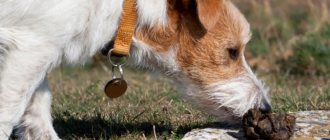Many dogs have dominant behavior. They try to make a person indulge their desires. This does not depend on the size of the pet: even mini dogs can subjugate the whole family. Such an animal requires discipline. This is especially true for the street. Dogs may get excited during a walk and pull on the leash. This leads to injuries and substitution of authority. Therefore, you need to know how to wean your dog from pulling on the leash while walking.
Why does the dog pull on the leash?
One of the common problems that dog owners face is controlling their behavior on the street. Many dogs begin to tug on the leash, causing discomfort to themselves and their owner. As a result, the pleasure of walking is lost. Animals often injure their necks and suffer from suffocation attacks. To wean your dog from pulling on the leash, you need to understand what motivates it. The main reasons for this behavior:
- Imposing a route. The animal does not respect the owner enough and sets the direction of movement. As a result, the dog begins to walk the person.
- Owner's mistakes. It’s not easy to wean your dog off a bad habit on your own. People often use the jerk method without realizing that they are contributing to an unwanted reaction. Before the jerk, the tension on the leash is released, which causes the pet to associate it with pain. Tension = safety.
- Excited state. Dogs can be mentally unstable. They break from the leash, cannot concentrate on a walk, and bark constantly and loudly. Such animals should be handled by an instructor and a zoopsychologist. Psychological problems cannot be solved by house training.
- Using a roulette leash. This type of ammunition causes heated debate among dog lovers. One of the main disadvantages of roulette is that the dog controls the distance. In addition, the leash is constantly taut. The animal gets used to the lack of air and considers it normal.
Non-standard behavior is always justified. The owner should not treat the pet as a trespasser. He has no goal to annoy a person. The first thing you need to understand is that dogs don't think like people.
How to treat furniture to prevent a dog from chewing it
You can buy a product to prevent your dog from chewing furniture at a pet store. They have an unpleasant taste and a repulsive odor.
Popular means include:
- Spray Mr. Fresh “Protection against chewing for dogs”;
- Spray Delix Charm “Weaning dogs from chewing household items”;
- STOP-SPRAY for animals “Does not scratch, does not chew”;
- Uniclean anti-gnaw-anti-scratch spray.
How to anoint furniture, folk methods:
- alcohol tincture of hot pepper;
- decoction of wormwood, mint;
- grate with chili pepper;
- spray with diluted vinegar;
- lemon, lime, grapefruit juice;
- Some pets cannot stand the smell of chlorine or alcohol.
Methods for weaning yourself from pulling
When training your dog, you need to give up the tape measure and choose a leash of medium length: from 3 to 5 m. It is very important not to change it during training. If necessary, you can change the collar. Many dogs continue to break away from the roulette wheel even after successful training. In order not to provoke a “relapse”, it is recommended to refuse it. Also, jerk training is excluded from training. The insidiousness of this method was described above.
For training to be worthwhile, you need to follow simple rules:
- Do not change direction depending on the dog's wishes. When the pet starts to pull on the leash, you need to stop, turn in the other direction and lead the dog with you. You can move like a snake, figure eight, and loop around the site. This will make your pet understand that ease of movement depends on coordinated actions.
- If the pet has done everything correctly, it must be praised. You cannot raise a dog by shouting and swearing. This provokes a desire to run away, which means pulling on the leash. Obedience should have a positive response.
- The leash must be of constant length. It can be three or five meters. It is fixed in two positions: when the dog is at the leg and at full length. This will help optimize the learning process.
- Avoid using a leash. Even rare use can provoke an “attack” of disobedience.
- Change direction as often as possible. If the pet does not know where the person will go, he will be forced to follow the route.
- Learning starts with simple things. The first classes are carried out in a calm, irritant-free place. There should be no cats, cars, passers-by people or dogs. The difficulty level should be increased gradually. The same applies to the duration of classes. A dog that is not accustomed to regular lessons will not be able to maintain attention for long.
A puppy should not be put on a leash before the fourth month of life. At this time, you need to allow him to communicate with his relatives and learn their “language.” If a dog is protected from its relatives, it will grow up withdrawn and unadapted. Don't worry if your baby starts to break from the leash: it won't be difficult to wean your puppy off the bad habit.
If the owner does not give the pet minimal freedom during a walk, it begins to react aggressively to the leash: gnawing on it and trying to free itself. This occurs due to tugging, a ban on approaching relatives, and an uncomfortable length.
In some cases, the dog chews on the leash to manipulate the person. The dog notices that when he bites into the leash, the owner lets him run free and starts playing. The dog uses this technique to attract attention. To discourage your dog from playing with a leash, you can create unpleasant associations. For example, “shoot” with a water pistol or lightly hit the rump when she grabs the ammunition.
The method of switching attention is no less effective. As soon as the pet begins to chew on the leash, the owner takes out a toy or object for fetching. You need to throw the leash on the ground and show the dog the toy. When he concentrates on the object, you need to pick up the ammunition and continue the walk, distracting the dog with a toy.
Video instruction
Please watch this video. In our case with Jack, it was precisely this technique that helped. Now, if necessary, Jack walks next to me, and the leash is not taut, but lies calmly in my palm.
Today we together tried to figure out why a dog pulls on the leash while walking, what is the reason for this behavior and how to wean a four-legged dog from this behavior. And no matter how long you and your little tail have to “gnaw the granite of science,” the main thing is to believe that sooner or later everything will work out for the fluffy one. But only in your power to help him with this.
Have you ever encountered a problem when your dog pulls the leash in different directions during a walk? How did you deal with this? Share useful tips with us.
Good luck and take care of your pets!
Choosing the right ammunition
Ammunition is of great importance. Without a properly selected leash and collar, training is pointless. An uncomfortable collar can cause aggression. Some owners specifically buy ammunition that causes pain to speed up the learning process.
You can't do that. The collar should be comfortable and of the correct size and width. Pet stores offer a wide range of ammunition, which can be difficult to choose from. The most popular types:
- Leash. It is a durable tape with a loop handle. The ends of the tape are equipped with a carabiner. It can be short, medium (3-5 m) and long/loose (10-12 m). Medium is optimal for walking, free - for training.
- Roulette leash. Convenient for walking, but not suitable for dogs that strain from their leash. The tape measure is constantly tense, so the animal quickly gets used to the unpleasant sensation, and it is more difficult to influence it. Not suitable for training.
- Short leash. It is a short cord with a loop handle. Equipped with a carabiner. Designed for "close" walking, not suitable for training.
- Parfors. This is a barbed collar for training hunting dogs. There are spikes on the inner surface. Suitable for training hunting breeds and used in exceptional (!) cases.
- Noose. The collar tightens like a noose when the dog begins to tear. Training with a noose is justified in the case of large, difficult-to-control animals.
- Halter. During tension, it compresses the dog's muzzle, not the neck. Outwardly similar to a muzzle, but designed to correct behavior. With its help, dogs are trained to walk next to their owner and not pull on the leash.
- Electroshock collar. Operates in vibration warning mode and electric shock mode. The force of the discharge is comparable to a shock of static electricity. Used for training aggressive dogs.
- Harness. Ideal for well-mannered dogs. Does not restrict movement and does not put pressure on the neck.
If you choose the right equipment, your training will be successful. To wean an adult dog from pulling on a leash, it is recommended to buy a halter. The pressure in the muzzle area will be unusual for the pet, and he will try to readjust.
Why is pulling dangerous?
Walking with a constantly vomiting pet is unpleasant in itself. But when the dog pulls hard on the leash, it also threatens injury for the pet and the owner. So:
- if the pet pulls the ammunition, the person may suffer dislocations of the shoulder, hand, or elbow;
- a tight collar compresses the throat, makes breathing difficult, leading to coughing, wheezing, and suffocation.
Over time, the animal gets used to walking only with a leash that is cracking from tension. He doesn't like it as much as the owner does. But the pet doesn’t see a way out and continues to “pull the strap.”
Reward and punishment - mistakes of owners
The training process is impossible without encouragement and approval. There is no need to scold the dog and move in its direction: it will try to avoid “retribution” and will pull the leash with redoubled force. The pet must voluntarily follow the owner’s commands, so success is rewarded with treats and affection.
Often the training process is delayed due to mistakes by the owners. These include:
- Following the dog. It is important not to forget that the owner walks the pet, and not vice versa! The animal needs to be given room to maneuver so that it can sniff the marks and communicate with its relatives. At the same time, the route is chosen by the owner. It determines the degree of freedom and sets the direction of movement.
- Encouraging arousal. Nervous dogs should be distracted with toys or fetch, rather than having their wishes granted.
- Jerk method. As already mentioned, dogs quickly get used to educational measures, even if they are unpleasant. The dog will associate a tight leash with a comfort zone, and a loose leash will expect pain. Therefore, it is better to abandon this method.
The training should be on a positive note. The dog does not understand the meaning of training. She behaves the way she is used to. The pet does not know why the owner uses brute force: education should be accompanied by encouragement.
If the owner exercises the dog regularly and correctly, the results will not be long in coming. You can train puppies and adult dogs. The main thing is to find an approach to them.
On a walk
After walking on a leash has been practiced at home, you can go outside. It is best to choose a sports ground, park or wasteland. The main thing is that there are no other dogs, crowds of people, and especially cats around.
Only after making sure that there is no “irritant” nearby, fasten the leash to the collar, and start training walking together and the “near” command. Don't forget to reward your puppy's efforts with treats.
Some dogs get used to this type of walking quickly, others will take longer. Only after the commands have been worked out can you go straight out of the house with a leash.
Warnings
- Do not leave your dog unattended while wearing a choke collar. A dog can easily get caught on something and choke, even if the collar is loose enough.
- Don't overload your dog with training. Limit your first lessons to 30 minutes or less. Don't "punish" your dog by scolding, yanking on the leash, or hitting him. This kind of out-of-control behavior on your part only shows your dog that you don't value control and may cause him to pull even harder on the leash.
- It is best not to use choke collars or restraint collars without first receiving instruction (from a training instructor, behavior analyst, or veterinarian) on the proper use of these training aids.











